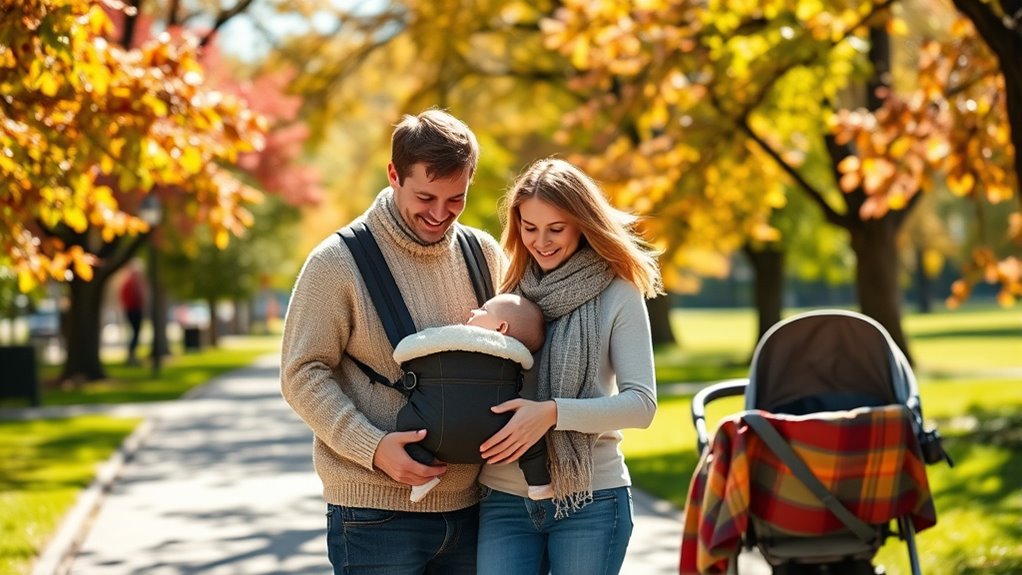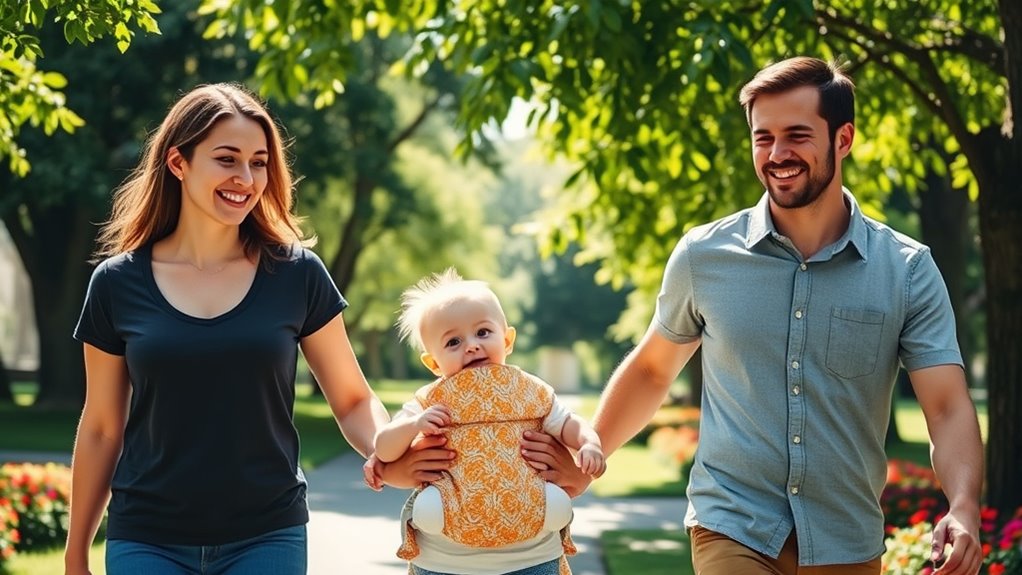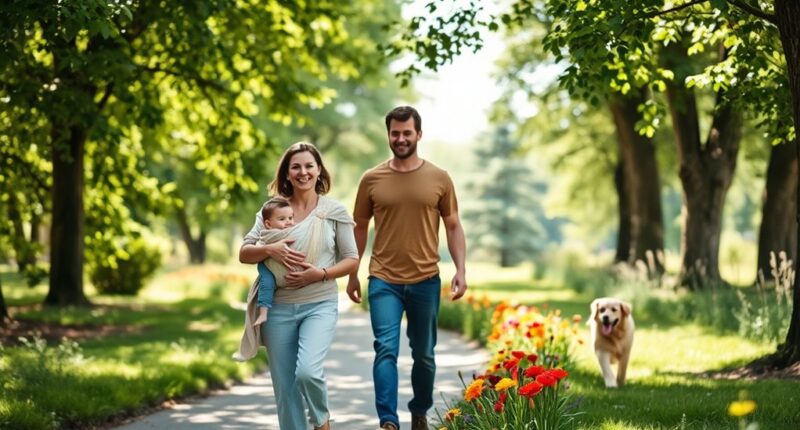Taking walks with your baby is a fantastic family activity that strengthens your bond while boosting both of your physical and cognitive development. The gentle movements stimulate your baby’s muscles and improve circulation for both of you. To guarantee a safe experience, dress your baby comfortably, pick a sturdy stroller or carrier, and start with short walks. As you explore the outdoors together, you’ll discover new things that pique your baby’s curiosity. Stick around to uncover more tips for an enjoyable journey!
Key Takeaways
- Walking with your baby stimulates muscle growth and supports cognitive development through exposure to new experiences.
- Prepare for your first walk by checking weather conditions and dressing your baby in comfortable layers.
- Use a safe stroller or carrier and ensure the home environment is baby-proof before heading out.
- Engage your baby during walks by pointing out colors, sounds, and textures to stimulate curiosity and learning.
- Take breaks to hydrate and rest, making walks enjoyable for both you and your baby.
Benefits of Walking With Your Baby

Taking walks with your baby offers a wealth of benefits that can enhance both your well-being and your child’s development.
Daily strolls stimulate muscle growth in infants through the gentle vibrations of a stroller or carrier while improving circulation for both of you. These walks provide a low-impact way for new mothers to regain fitness and shed post-pregnancy weight.
Daily walks boost infant muscle growth and circulation while helping new mothers regain fitness and lose post-pregnancy weight.
Your baby experiences new sights, sounds, and textures, which supports cognitive development and early language skills. Fresh air calms your baby, promoting emotional balance and better sleep.
These outings also create opportunities for social connections with other parents, encouraging friendships and a sense of community.
Establishing a walking routine sets a healthy lifestyle example, fostering lifelong habits for your child.
Preparing for Your First Walk

A successful first walk with your baby hinges on careful preparation. Start by checking the weather; avoid extreme conditions like heavy rain or intense heat. Dress your baby in layers to keep them comfortable.
Choose a stroller with sturdy wheels or a carrier for easier navigation. Before you leave, make certain your home environment is safe for your return. Select flat, smooth paths for your stroll.
Timing is key; wait until you’re fully recovered from delivery and plan walks when your baby isn’t overtired. Begin with short walks of 10-15 minutes, gradually increasing as you both adjust.
Finally, pack essentials like water, snacks, and age-appropriate toys to keep your baby entertained during the walk. Additionally, consider using a travel stroller designed for easy maneuverability and compact folding when venturing out.
Tips for a Safe and Enjoyable Walk

While you’re excited to explore the world with your baby, ensuring a safe and enjoyable walk is essential.
Start by choosing the right equipment, like a comfortable baby carrier or stroller with a safety harness. Avoid baby walkers and instead use stationary standers.
Choosing the right gear, like a safe baby carrier or stroller, is crucial for your baby’s comfort and safety.
Before heading out, baby-proof your home and check the weather to avoid surprises. Stay alert for hazards like uneven paths or sharp objects, keeping a safe distance from water.
Bring along essentials such as diapers, snacks, and a first aid kit. If accidents happen, remain calm and reassure your baby.
Adjust your route based on their comfort, and don’t forget to take breaks to hydrate and rest during your adventure.
Engaging Your Baby During the Walk

As you stroll with your baby, engaging their senses can turn a simple walk into an enriching experience. Point out the vibrant colors of flowers, the rustling leaves, or the distant sounds of birds. These observations stimulate their developing brain and spark curiosity. You can enhance their experience by using trailer music to create a soothing atmosphere during your walks, which can be calming and engaging for both you and your baby.
Describe what you see, helping your baby make connections and expand their understanding of the world. You can also use intriguing toys, placing them just out of reach to encourage movement. Incorporating educational toys during your walks can further support their cognitive and physical development. For example, toys like the Montessori Busy Book can enhance cognitive development and keep your baby engaged throughout the walk. Bubbles or balloons can invite exploration, while walking barefoot allows your baby to feel different textures, enhancing their sensory experience.
Interacting with nature not only promotes fun but also fosters a deeper appreciation for the outdoors, all while supporting your baby’s cognitive and physical development.
Building Confidence and Independence

Building confidence and independence in your baby is essential as they commence their walking journey. Start by creating a safe, baby-proofed environment that encourages exploration. Let them practice cruising along furniture from around 9 to 13 months, which helps build balance. Encourage activities like squatting to strengthen their leg muscles. Offer push toys for support as they take those first steps. Engaging in physical activity during the day can promote better sleep at night, benefiting their overall development.
Going barefoot enhances their sensory feedback, vital for healthy foot development. Celebrate small victories and provide emotional support when they stumble, fostering resilience. Additionally, early investments in their physical development can lead to long-term benefits in mobility and coordination.
Frequently Asked Questions
When Should I Start Taking Walks With My Baby?
You can start taking walks with your baby soon after birth, as long as the weather’s comfortable.
Just make sure it’s not too hot or cold outside. Begin with short walks of about 20-30 minutes, gradually increasing the duration as your baby gets used to it.
Always check the stroller for safety, and keep your baby shielded from direct sunlight during the day.
Enjoy the fresh air and bond during these outings!
How Long Should Our Walks Be Initially?
Initially, you should keep your walks short, around 10 to 15 minutes. This helps prevent fatigue and keeps your baby comfortable.
Pay attention to their cues; if they seem tired or fussy, it’s time to head back. As your baby gains confidence and strength, gradually increase the duration.
What Should I Bring on Our Walks?
“An ounce of prevention is worth a pound of cure.”
When you’re planning your walks, pack essentials like diapers, wipes, and a changing pad.
Don’t forget a baby carrier or a sturdy stroller with safety features.
Bring snacks and drinks for both you and the baby, along with a lightweight blanket for breaks.
Finally, include favorite toys to keep your little one entertained and a phone for emergencies.
Enjoy your time outdoors!
Can I Use a Stroller or Carrier?
You can definitely use either a stroller or a carrier, depending on your needs.
If you’re planning a longer walk, a stroller offers storage and comfort for both of you.
However, if you’re maneuvering through crowded spaces or want that close bond, a baby carrier is great for hands-free mobility.
Think about where you’re headed and what activities you’ll be doing to decide which option suits you best.
How Do I Handle Weather Changes During Walks?
When you step outside, it’s like entering a domain where Mother Nature plays her tricks.
To handle sudden weather changes, keep your eyes on forecasts and prepare for the unexpected. Layer your clothing and have rain gear handy. If it starts pouring, don’t hesitate to use an umbrella or find shelter.
Conclusion
Walking with your baby isn’t just a great way to get fresh air; it’s a chance to bond and explore the world together. By preparing properly and keeping safety in mind, you’ll create enjoyable experiences that nurture your baby’s curiosity. So, why not lace up those shoes and step outside? Each stroll you take not only boosts your baby’s confidence but also helps you both connect with nature and each other in meaningful ways.









